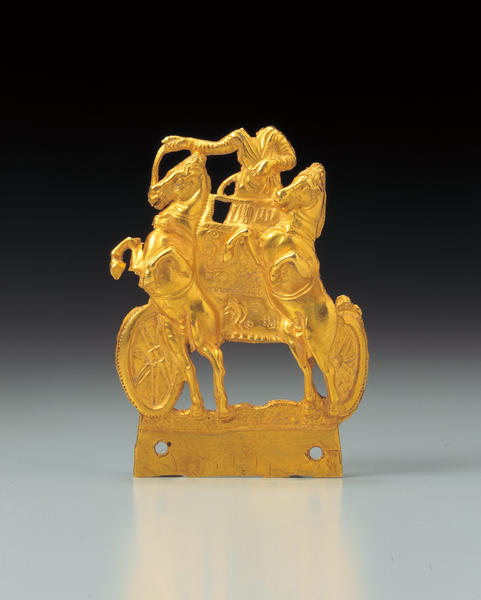馬車形装飾板
- 紀元前4世紀頃
- 金
- H-3.6 W-2.7
解説(古代バクトリア遺宝展)
前4世紀頃
金
高3.6 cm 幅2.7 cm
金板の押し出しと彫金で大変劇的な二頭立て戦車の意匠を作り出している。御者の頭部は失われているが、ベルトを締めたチュニックを着、右手に鞭、左手に手綱を執っている。長い袖はたくし上げられ皺がよっている。二頭の馬は後脚で立ち上がり、前脚の膝を曲げている。馬の胸を締める馬具の中央はダイヤモンド形になっており、腹部をベルトで締めている。戦車の前面は多くのロゼット文とパルメット文で装飾され、両輪には8本のスポークが刻まれている。この戦車がペルシャ人の御す表現をとっているのに対し、馬の頭部はアラビア馬風の鼻柱の形状であり、作品33に見られるような馬による民族の区別を意識していない。これは僅か3.6×2.7センチ程の小さな金板に卓越した職人技で精緻に作り出されたもので、ギリシャ系職人の手になるものであろう。
Catalogue Entry
ca. 4th century B.C.
Gold
H. 3.6 cm, W. 2.7 cm
A gold sheet has been pressed and sculpted into a dramatic rendition of a two-horse chariot. The driver's head is missing, but we can see that he is wearing a belted tunic, has a whip in his right hand, and the reins in his left hand. His long sleeves are shown with wrinkling down their entire length. The two horses rear up on their hind legs, with their forelegs folded at their chests. Diamond-shaped forms adorn the center of the horses's chest bands, and a girth circles their bellies. The front of the chariot is adorned with a large number of rosette and palmetto designs. Both wheels are incised with eight spokes each. While the driver appears to be a Persian, the horse heads are shown with the finely sculpted nostrils of Arabian horses. The origin of the maker of this work cannot be determined by the type of horse shown, as is the case in cat. No. 33. This superb example of an artisan's work measures a mere 3.6 x 2.7 cm, and was surely created by a Greek school artisan.
